 Contents
Contents
- video: practical tips on succinct and evidence-based section 31 applications
C110a Application form and Social Work Evidence template
- templates, guidance and case studies:
- blank document templates for your use
- video: the importance of documentation
- list of supporting documents required for cases
- video: practitioners discuss section 31 applications and the role of the Case Manager
- local practice examples
- tips for practice on constructing genograms
- case law with an impact on court applications
- e-learning materials for this topic
What you need to know
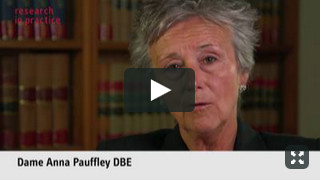 Succinct and evidence-based Section 31 Applications – Mrs Justice Anna Pauffley DBE.
Succinct and evidence-based Section 31 Applications – Mrs Justice Anna Pauffley DBE.
Running time: 02:37
Download video direct from Vimeo
Also viewable online via Adobe Connect
(having trouble playing our videos?)
As noted in the Statutory guidance on court orders and pre-proceedings The Children Act 1989 is based on the principle that, where consistent with children’s welfare, local authorities should promote the upbringing of the child by their families. Where a decision is taken by the local authority that parenting cannot be improved within the child’s timescale and that the ‘threshold’ for care proceedings has been met in principle, it should determine whether to bring proceedings as quickly as possible. Recent case law has raised important issues for those working in this arena. A joint response to this case law, from ADCS and Cafcass, can be found in their joint letter.
Applications for care/supervision orders must be conducted in accordance with Family Procedure Rules Practice Direction 12A (known as the ‘Public Law Outline’). The Outline was revised in April 2014: source documents are available from the UK Judiciary Public Law pages.
The application is commenced using the application form C110A. The form, normally completed by the local authority legal adviser, includes a threshold statement on pages 9-10, which is an outline of the facts that it will seek to establish by evidence or agreement to satisfy the section 31(2) criteria. This is not to exceed two pages.
Templates and guidance
This section includes the Social Work Evidence Templates and guidance and the C110A Application template (with worked example).
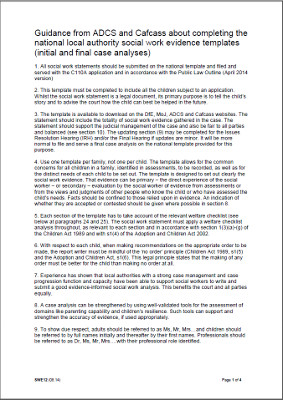 Before using the templates below, please view the ADCS and CAFCASS guidance:
Before using the templates below, please view the ADCS and CAFCASS guidance:
Download SW12 ADCS and CAFCASS guidance final_(06/08/14)A .PDF file .PDF file
Social Work Evidence Template (SWET)
Documents in this area for your use include:
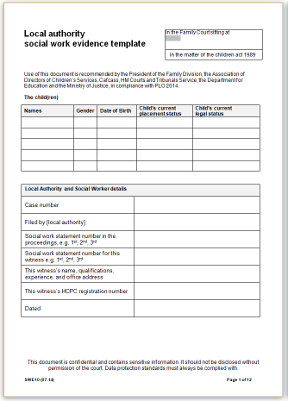 SWE10 Local authority Social Work Evidence Template – blank for use
SWE10 Local authority Social Work Evidence Template – blank for use
SWE10 Local authority social work evidence blank template (16/02/16)
Word 97-2003 .DOC file
You can add rows to the chronology and section 3.2 by simply using ‘tab’ at the end of the final row to create further rows, as in any normal MS-Word table.
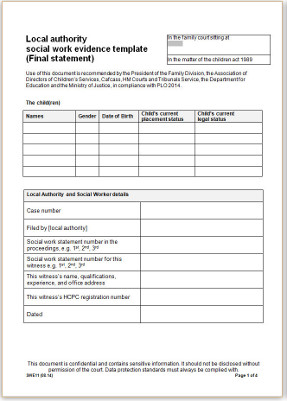 SWE11 Local authority social work final analysis – blank for use
SWE11 Local authority social work final analysis – blank for use
SWE11 Local authority social work final analysis blank template final (09/02/16)
Word 97-2003 .DOC file
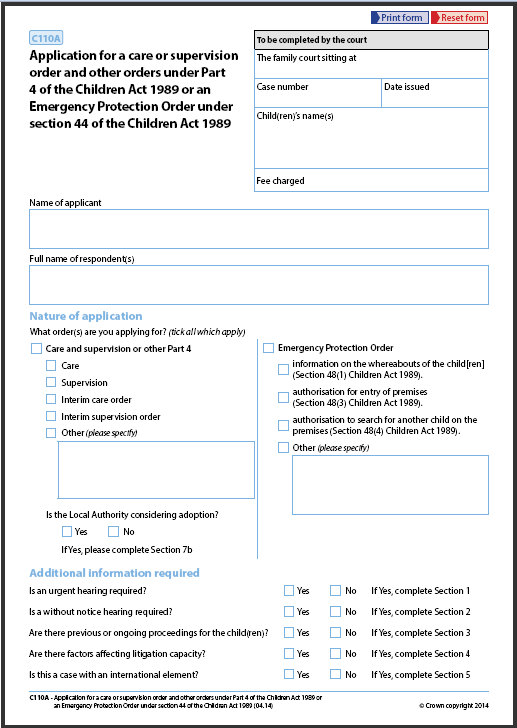 C110A Application template – blank for use
C110A Application template – blank for use
Download: C110A Application blank template final (13/08/14)A .PDF file
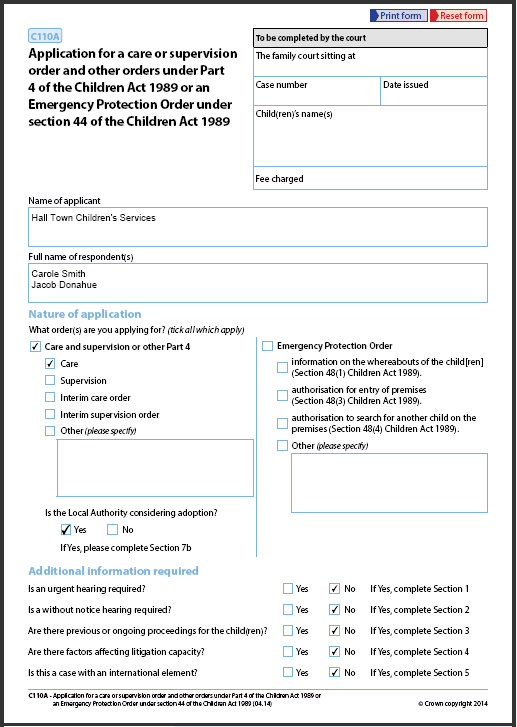 C110A Application populated case study:
C110A Application populated case study:
Download: C110A Application populated case study final (13/08/14)A .PDF document
Supporting Documentation
 The importance of documentation from the perspective of the parents and their solicitor – Katherine Gieve.
The importance of documentation from the perspective of the parents and their solicitor – Katherine Gieve.
Running time: 05:46
Download video direct from Vimeo
Also viewable online via Adobe Connect
(having trouble playing our videos?)
The application must be accompanied by the Annex documents, which are listed on page 21 of the application form C110A (an example can be found below):
1. The social work chronology
This should be succinct and relate to significant events rather than detailing everything that has happened, with a focus on the previous two years. Longer chronologies may be needed in order to provide evidence of maltreatment that has caused significant cumulative harm such as neglect, where parents have a pattern of making short term improvements that are not sustained or when older children have been removed. See also Pre-proceedings: chronologies
2. The social work statement and genogram
The social work statement is limited to the evidence listed in Part 7 of the Outline. The President of the Family Division has stated an expectation that this statement should not exceed four to five pages (see View from President’s Chamber (2)). For more information on completing succinct and evidence based assessments see the section on Assessements and for assessment of family and friends see the section on Family and Friends Placement.
The social work statement is limited to the evidence listed in Part 7 of the Public Law Outline (http://www.judiciary.gov.uk/related-offices-and-bodies/advisory-bodies/fjc/guidance/familycourtguide/publiclaw/practice-directions/). The President of the Family Division has stated an expectation that this statement should not exceed four to five pages
3. Current assessments
The court will expect any connected persons’ assessments to be completed before the application is made to court. See also Pre-proceedings: family and friends placement. Any issue relating to the capacity of parents or to an international element are to be set out in the application form C110A.
4. The care plan must be drafted in accordance with the Care Planning, Placement and Case Review (England) Regulations 2010 (as amended). See also the Fostering and Adoption section on care plans for tips on developing effective care plans.
5. Index of Checklist Documents
As well as the C110A form and the Annex documents, the local authority will also have to review its files and prepare a list of all the documents in its possession relating to the child/family prepared in the last two years. These are known as the Checklist Documents.
The Index of Checklist Documents must be divided into two categories: ‘Evidential Documents’ (such as previous court orders) and ‘Decision-making Records’ (such as minutes from strategy meetings and child protection conferences). The Evidential Documents must be served on all parties, and the parties can also request copies of the Decision-making Records.
However, in order to minimise the amount of documentation considered by the court, none of the Checklist Documents should be filed with the court unless the court directs that they must be filed.
It should be noted that when court applications are filed using the evidence template, the requirement for documentation remains the same. However the statement contains some of the documents, which will not need to be filed separately. For more information see the section ‘Evidence Template’.
Learning resources
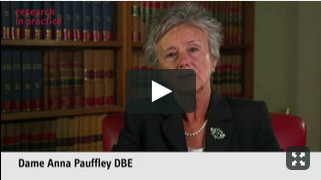 Section 31 Applications – Mrs Justice Anna Pauffley DBE.
Section 31 Applications – Mrs Justice Anna Pauffley DBE.
Running time: 02:40
Download video direct from Vimeo
Also viewable online via Adobe Connect
(having trouble playing our videos?)
Local practice examples
![]() Local authorities have developed their own protocols summarising the requirements of the PLO and requirements for court. As an example, see the Sussex Family Justice Board PLO Pocket Guide.
Local authorities have developed their own protocols summarising the requirements of the PLO and requirements for court. As an example, see the Sussex Family Justice Board PLO Pocket Guide.
Tips for practice on constructing genograms
![]() Our tips sheet for practice on constructing genograms with families is available as a PDF.
Our tips sheet for practice on constructing genograms with families is available as a PDF.
Examples of genograms are available at the Social Care Institute for Excellence (SCIE) website
Case law with an impact on court applications
Case law which affects cases coming to court in which the plan for the child is adoption has been published in 2013. The appeal and judgment can be found here, Re B-S and Re B (Children) [2013]
The Adoption Leadership Board, issued a ‘Myth Busting’ guide, to address perceived changes to adoption practice, planning and assessments as a result of different interpretations of recent court judgments (Re B and Re B-S).
A copy of the guide can be found at the BAAF website, together with a press release explaining the guide.
It is important for practitioners to keep up to date with case law and judgments which will have implications on the way court submissions are prepared and evidenced. Research in Practice produces a monthly overview and analysis of selected public law cases, highlighting implications and recommendations for practice.
 The steps of a Section 31 application – Uma Mehta, Islington.
The steps of a Section 31 application – Uma Mehta, Islington.
Running time: 02:25
Download video direct from Vimeo
Also viewable online via Adobe Connect
(having trouble playing our videos?)
Documentation needed for court application
Uma Mehta, Chief Lawyer, Community Services Team at the London Borough of Islington, discusses section 31 applications, documents that need to be filled and served and the roles of the different team members when completing and filling the application.
 The role of the case manager – Julie Penny.
The role of the case manager – Julie Penny.
Running time: 02:16
Download video direct from Vimeo
Also viewable online via Adobe Connect
(having trouble playing our videos?)
The role of the case manager
Julie Penny, Principal Social Worker at the BCC Directorate for People, describes the role of the case manager.
For more information on the role of the case manager go to Pre-proceedings: introduction to pre-proceedings: learning resources
Test your knowledge
These exercises aim to help you embed knowledge in this area. A range of different formats have been used, and most can be used individually or in team learning. Discussing your learning with your supervisor will help to ensure it informs your practice
Start test






